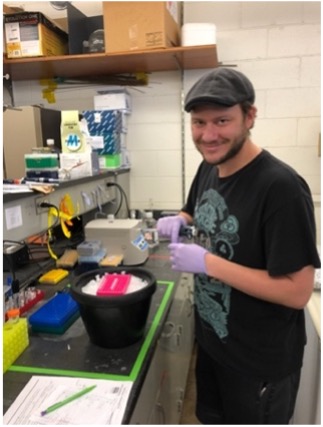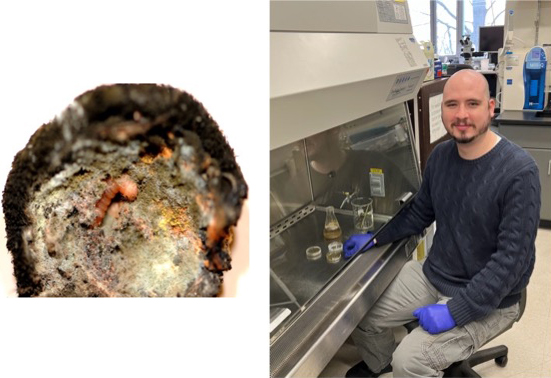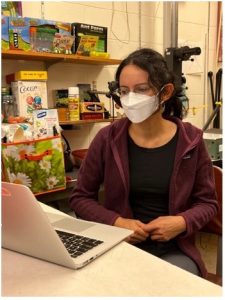Current projects, with select recent publications
Antagonistic interactions between plants and insects—herbivory

A longstanding focus for research in the Berenbaum lab has been elucidating the genetic and biochemical mechanisms by which selection pressure from insect herbivores influences the diversification and production of phytochemicals and the extent to which the selective impact of phytochemical toxicity influences diversification of behavioral and biochemical adaptations in plant-feeding insects. Oligophagous caterpillars (especially those in the family Depressariidae) and their hostplants in the family Apiaceae that produce toxic phytochemicals (especially furanocoumarins) continue to be a research theme. Of particular interest is how associations are genetically and phytochemically restructured as human activities move coevolved insects and hostplants around the world, independently or together, to invade and become established in new habitats.
Select recent publications
Harrison, T.L., C.A.E. Dean, K.S. Parks, M.R. Berenbaum, 2016. Depressaria depressana (Fabricius) (Lepidoptera: Depressariidae), new to the midwestern USA. J. Lep. Soc. 70: 169-173.
Calla B, WY Wu, CE Dean, MA Schuler, MR Berenbaum, 2019. Substrate-specificity of cytochrome P450-mediated detoxification as an evolutionary strategy for specialization on furanocoumarin-containing hostplants: CYP6AE89 in parsnip webworms. Insect Molecular Biology, 29(1), 112-123. doi: 10.1111/imb.12612
(Please view our archived web site for an account of earlier work on depressariid moths and papilionid butterflies)
Mutualistic interactions between plants and insects—pollination

Bees are among the only animals on Earth that can complete their life cycles consuming only nectar and pollen; gathering sufficient amounts of these ephemeral sources requires specialized behavior, morphology, and physiology. Pollinator decline is a global phenomenon with profound implications for both the structure of the terrestrial world and, by affecting food security, prospects for human health. Declines in US managed honey bee colony numbers as well as wild native bee species populations have been associated with pesticides, pathogens, parasites, and poor nutrition. We’re focused on effects of insecticides and fungicides on hive health and social function in honey bees and the impacts of phytochemical diversity on honey bee health in pesticide-contaminated environments.
Select recent publications
Berenbaum MR, Liao LH, 2019. Honey bees and environmental stress—toxicologic pathology of a superorganism. Toxicologic Pathology, 47(8): 1076-1081 https://doi.org/10.1177/0192623319877154
Liao L-H, W-Y Wu, A Dad, MR Berenbaum, 2019. Fungicide suppression of flight performance in the honey bee (Apis mellifera) and its amelioration by quercetin. Proc. Roy. Soc. B 286: https://doi.org/10.1098/rspb.2019.2041
Berenbaum, M.R. and B. Calla, 2021. Honey as a functional food for honey bees. Annual Review of Entomology 66: 185-208; https://doi.org/10.1146/annurev-ento-040320-074933
Liao, L-H, DJ Pearlstein, W-Y Wu, A Kelley, W Montag, EM Hsieh, MR Berenbaum, 2020. Increase in longevity and amelioration of pesticide toxicity by natural levels of dietary phytochemicals in the honey bee, Apis mellifera. PLoS ONE, 5(12), e0243364. https://doi.org/10.1371/journal.pone.0243364
Mutualistic interactions between herbivorous insects and fungi

Extreme variation in the ability of insects to utilize phytochemically diverse hostplant families as food sources has defied easy explanation. Beyond intrinsic genetically based biochemical mechanisms, symbiotic associations may facilitate expansion of diet breadth by contributing detoxification functions. In contrast with intracellular heritable bacterial symbionts, microbes living outside the insect body (environmental symbionts) may be important, too. Fungi can form facultative mutualisms with insect herbivores, including lepidopterans. Aspergillus flavus is a facultative mutualist of the navel orangeworm Amyelois transitella (Lepidoptera: Pyralidae), a pest of orchard tree nuts and fruits in at least five phytochemically diverse plant families. In a long-time collaboration with Joel Siegel, USDA-ARS at Parlier, we found this fungus detoxifies natural and synthetic toxins that larvae encounter in their diet. Recognizing the role of environmental symbionts is important for developing new more sustainable approaches to managing navel orangeworm and other pests partnered with fungi.
Select recent publications
Berenbaum, M.R., Bush, D.S. and Liao, L.H., 2021. Cytochrome P450-mediated mycotoxin metabolism by plant-feeding insects. Current Opinion in Insect Science, 43: 85-91; https://doi.org/10.1016/j.cois.2020.11.007
Bush, D.S., Siegel, J.P. & Berenbaum, M.R. 2018. Accelerated development and toxin tolerance of the navel orangeworm Amyelois transitella (Lepidoptera: Pyralidae) in the presence of Aspergillus flavus. J Chem Ecol 44, 1170–1177 (2018). https://doi.org/10.1007/s10886-018-1027-0
Genome-encoded mechanisms for coping with natural and synthetic toxins

Cytochrome P450s comprise a gene superfamily encoding enzymes responsible for the bulk of Phase 1 detoxification of xenobiotic substrates as well as biosynthesis of endogenous substrates, including pheromone and hormones in insects. In 1991, CYP6A1 in the house fly Musca domestica was the first cytochrome P450 associated with insecticide resistance, and a year later, the Berenbaum lab characterized the first P450 involved in phytochemical detoxification, CYP6B1, which detoxifies furanocoumarins in the black swallowtail Papilio polyxenes. Since then, we have contributed to annotating P450 genes in genomes of five species in three orders and to investigating the biochemistry, molecular biology, and evolution of P450 enzymes, assigning function to >24 P450s in six insect species. We’re continuing to expand our genome-enabled work to understand mechanisms underlying the successes of insects in circumventing both natural and synthetic toxins, most recently in Apis mellifera and the pyralid caterpillar Galleria mellonella, or waxworm, a pest of Apis mellifera nests.
Select recent publications
Demkovich MR, B Calla, E Ngumbi, BS Higbee, JP Siegel, MR Berenbaum, 2021. Differential regulation of cytochrome P450 genes associated with biosynthesis and detoxification in bifenthrin-resistant populations of navel orangewom (Amyelois transitella). PLoS ONE: 16(1), e0245803.
Demkovich, M., B. Calla, J. Siegel, and M.R. Berenbaum, 2020. Selective sweeps in a nutshell: the genomic footprint of rapid insecticide resistance evolution in the almond agroecosystem. Genome Biology and Evolution evaa234, https://doi.org/10.1093/gbe/evaa234
Calla, B., MacLean, M., Liao, L.-H., Dhanjal, I., Tittiger, C., Blomquist, G. and Berenbaum, M. 2018. Functional characterization of CYP4G11—a highly conserved enzyme in the western honey bee Apis mellifera. Insect Mol Biol, 27: 661-674. https://doi.org/10.1111/imb.12516
Home | Publications | Research | People | In the News | Join the Lab | Contact | Old Site (Prior to 2022)